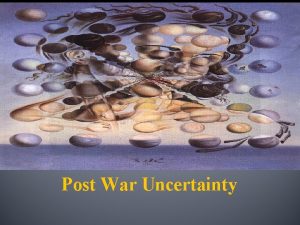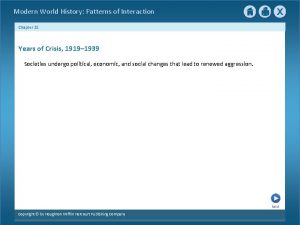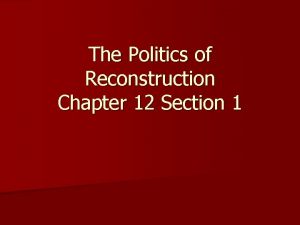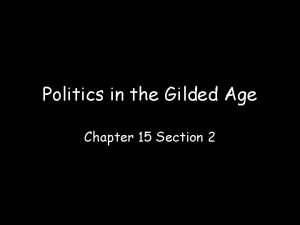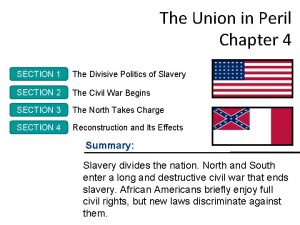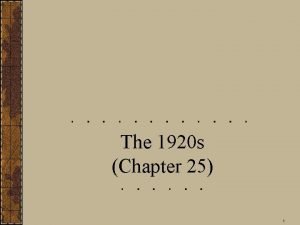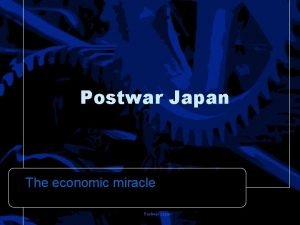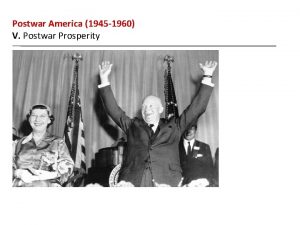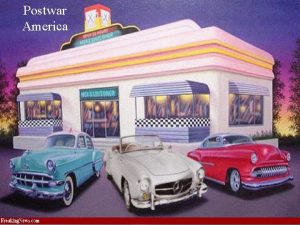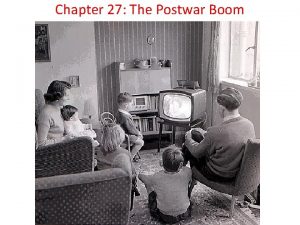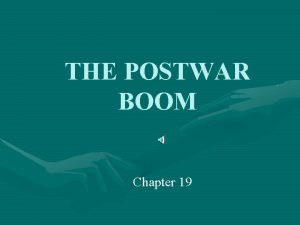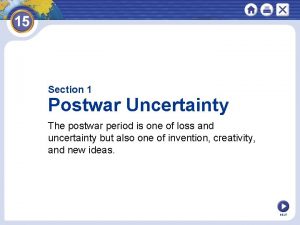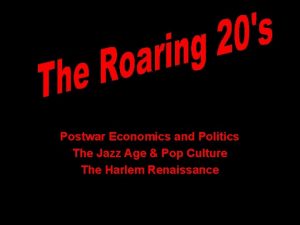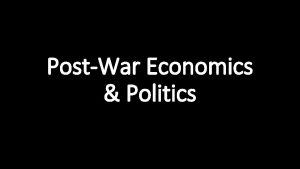Postwar Economics and Politics Chapter 24 Section 1










- Slides: 10

Postwar Economics and Politics Chapter 24 Section 1

America After World War I n n n Key ? – What did Warren G. Harding offer Americans as president? Postwar economy struggled – many people out of work. Americans blamed Europe, immigrants, and Wilson. Fordney-Mc. Cumber Tariff – 1922 – bill passed which set the highest tariff on foreign goods in U. S. history. Imported goods very expensive – enabled U. S. to keep their prices high.

Postwar Politics 1920 – campaign – Harding –”return to normalcy”. (Republican) n Supported lower taxes and less government regulation over business. n Rejected the League of Nations. n The 1 st election that women could vote. n Chose a pro-business cabinet to help him lower taxes and balance the budget. n

Mixed Industrial Success Key ? – What economic developments affected life in the 1920 s? n Economy grew rapidly. n 1913 – U. S. established income tax. n 1917 tax rate raised to 67%; 1924 reduced to 46%; reduced to 25% in 1925. n

The Transportation Industry n n n Cheap fuel powered the new prosperity; electric vacuums, washers, toasters, fans. Created new jobs. Henry Ford – Model T – wanted to make a car that everyone could afford. Assembly line – helped lower costs and increase productivity. Birth of the airline industry; uses for old warplanes; crop dusting, flight instructors etc.

Economic Problems n n New manufacturing processes turned out products faster and cheaper. As product demand rose, consumers relied on credit. Installment buying allowed consumers to pay for cars and purchases in small monthly payments. Companies protected by tariffs faced little competition; big companies regained monopoly control over many markets – prices rose.

Continued Machinery allowed farmers to produce more food than needed; drove food prices down. n Government policies favored corporate interests over social interests. n Income gap between rich and poor – highest ever – 50%. n Allowing investors to buy stocks on credit caused stock prices to rise rapidly. n

Coolidge Takes Over n n n Key ? What challenges did Calvin Coolidge face as president? Harding’s cabinet unqualified and corrupt. Teapot Dome – Sec. of Interior Albert Fall. Oil executives bribed Fall for access to oil-rich government land. Fall first cabinet member to be imprisoned. Harding died Aug. 2, 1923 – Coolidge became president.

Laissez-Faire Economics Coolidge cleaned up scandals and promised further strengthen pro-business policies. n Laissez-Faire economics – if business is left unregulated by the government it would benefit the nation. n Believed that government should not address social and economic problems. n Congress passed a bill to help farmers – Coolidge vetoed it. n

Prosperity Americans had more leisure time. n Labor-saving appliances and shorter working hours, higher wages. n By the end of the 20 s Americans spending money on movies, spent time listening to radio and attending sporting events; 100 percent jump in a decade. n All Americans did not prosper n
 Which form of art reflected postwar uncertainty?
Which form of art reflected postwar uncertainty? Chapter 19 section 3 popular culture
Chapter 19 section 3 popular culture Chapter 15 section 2 world history
Chapter 15 section 2 world history Philosophy, politics and economics michael munger
Philosophy, politics and economics michael munger Chapter 12 section 1 the politics of reconstruction
Chapter 12 section 1 the politics of reconstruction Chapter 15 section 3 politics in the gilded age
Chapter 15 section 3 politics in the gilded age Reconstruction and its effects
Reconstruction and its effects Chapter 4 section 1 the divisive politics of slavery
Chapter 4 section 1 the divisive politics of slavery Chapter 7 section 3 politics in the gilded age
Chapter 7 section 3 politics in the gilded age Chapter 14 postwar prosperity and civil rights
Chapter 14 postwar prosperity and civil rights Kerner commission apush
Kerner commission apush
